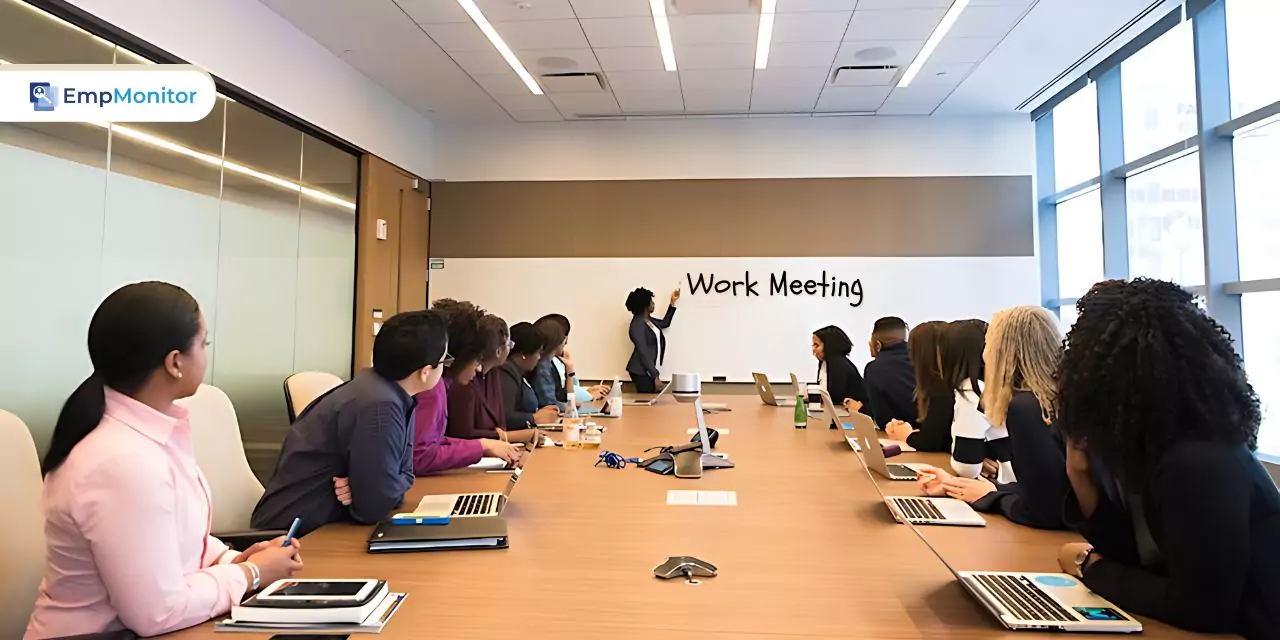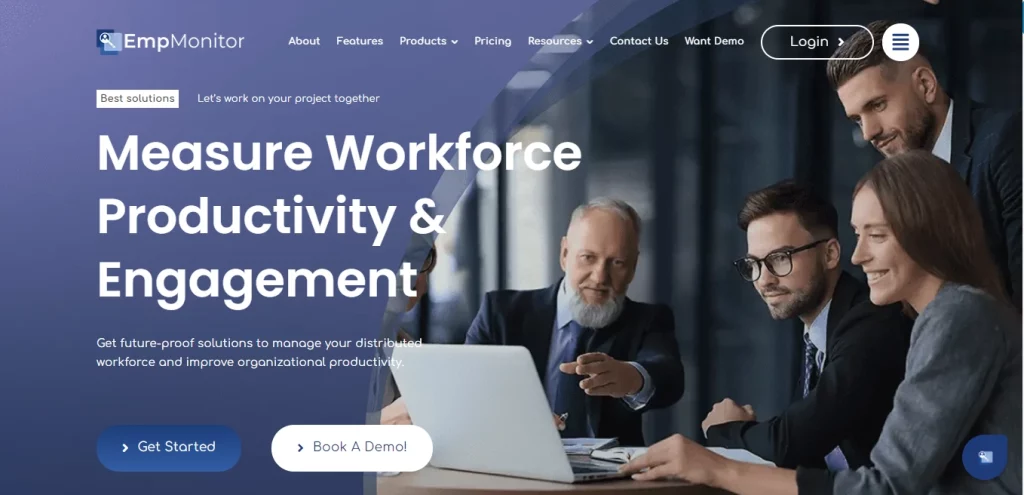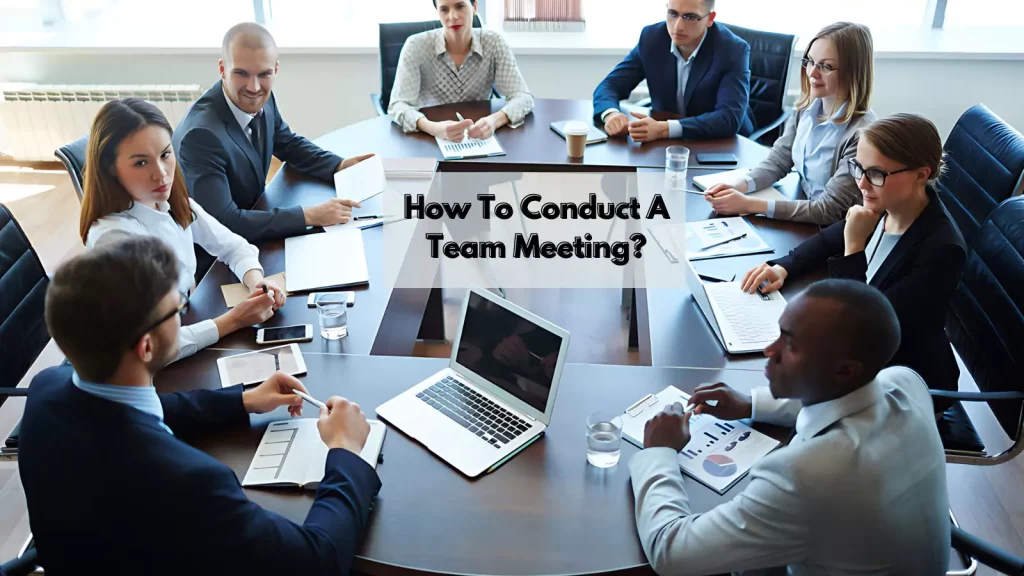Work meetings are essential for collaboration, decision-making, and team synergy in any organization. Love them or hate them, they play a pivotal role in shaping workplace dynamics and driving collective success. From sparking innovation in brainstorming sessions to charting the course forward in strategic discussions, effective meetings can be transformative.
This guide delves into the factors that make work meetings productive. We’ll cover strategies for fostering engagement, techniques for facilitating fruitful discussions, and various meeting types, all aimed at transforming your meetings into powerful team-tracking tools for achieving goals rather than time-consuming obligations and making your team meetings fun and engaging.
Join us!
LISTEN TO THE PODCAST NOW!
What Is The Purpose Of A Work Meeting?
The purpose of a work meeting is to efficiently share information and facilitate discussions around the topics at hand. A well-executed meeting allows employees to synchronize on agenda items, tackle concerns or obstacles, and clarify future actions.
Meetings can serve critical business functions such as disseminating company updates, sharing valuable information or training, or providing a space for informal team bonding and open dialogue.
Productive meetings are characterized by having a clearly defined purpose. As a manager, it’s essential to identify the specific goals of each meeting, whether it’s aligning the team, fostering good fellowship, or delivering crucial updates. Having a clear purpose ensures meetings stay focused and yield productive meeting outcomes.
The Importance Of A Work Meeting
Work meetings are highly significant for multiple reasons:
- Facilitates Enhanced Collaboration: Rather than working on projects independently, team meetings foster an environment where ideas are freely shared. This collaborative approach often leads to improved solutions and processes, benefiting from the diverse perspectives of team members.
- Enhances Communication: While emails and direct messages are efficient, meetings provide a platform for in-depth discussions on complex projects or new initiatives. They enable participants to ask questions, clarify details, and ensure everyone comprehensively understands the topic.
- Builds Team Familiarity: Meetings at work are crucial for fostering team cohesion, particularly in remote environments where virtual calls or video chats link distant team members. These interactions help colleagues strengthen relationships, grasp each other’s working styles, and improve teamwork. Workforce management software like EmpMonitor contributes by providing detailed productivity insights, which help in understanding individual work patterns and optimizing team dynamics.
Work meetings play a crucial role- in fostering collaboration, enhancing communication, and building teams, making them indispensable for effective team dynamics and project success.
9 Different Types Of Work Meetings
Work meetings come in various forms, each serving unique purposes and objectives within organizational dynamics.
1. Status Update Meetings
Status update meetings are a cornerstone of effective team communication, providing regular opportunities to discuss ongoing projects and ensure alignment on upcoming priorities.
These work meetings serve as vital check-ins where team members share progress updates and address any challenges or obstacles together. These sessions are instrumental in keeping everyone informed about current project statuses and team goals.
For instance, managers utilize these meetings to update project milestones and provide guidance on the next steps, ensuring project alignment and progress.
By fostering open dialogue and collaboration, status update meetings not only help remove obstacles but also- empower project managers with the information needed to oversee projects effectively.
2. Information Sharing Meetings
Information-sharing meetings are for organizations to circulate important updates and knowledge to their teams effectively. These meetings often involve presentations from stakeholders, sub-teams, or external speakers, covering topics such as company-wide announcements, new client introductions, upcoming events, product launches, and other pertinent information.
Types of information-sharing meetings can include company all-hands gatherings, training sessions, product demonstrations, and presentations by external parties.
While some information can be communicated via email, conducting these work meetings in a live setting offers distinct advantages. It allows for immediate clarification of- uncertainties, emphasizes key points, and encourages interactive discussions.
3. Decision-Making Meetings
Decision-making meetings are essential gatherings where teams unite to focus on achieving a shared goal by making informed decisions and solving problems.
These meetings involve various stages, from gathering and sharing information to evaluating potential solutions, voting on courses of action, or aligning on the implementation of decisions.
In decision-making meetings- every participant’s perspective is valued, ensuring that diverse viewpoints are considered. Facilitated by a clear leader, these work meetings harness collective wisdom and expertise to ensure decisions are well-informed and align with team and organizational objectives.
4. Problem-Solving Meetings
Problem-solving meetings are essential for addressing challenges that teams encounter, whether they involve business issues, internal dynamics, external pressures, or specific projects and goals. These meetings provide a platform to employ innovative techniques and exercises, encouraging fresh perspectives and fostering organizational change.
Problem-solving meetings vary in structure depending on the issue at hand. Participants bring their knowledge and expertise to the table, asking questions, providing insights, and collectively making decisions. The collaborative environment allows for brainstorming alternative solutions and developing strategies to prevent similar problems in the future.
5. Team Building Meetings
Team building meetings aim to foster collaboration, improve communication, and strengthen team cohesion within an organization.
These dedicated sessions are crucial in cultivating a vibrant company culture and ensuring team members feel connected and motivated. Activities can range from company away days and cross-team discussions to celebrating team achievements and engaging in interactive exercises.
Team building meetings often include structured activities like games or icebreaker questions to promote togetherness and build relationships among team members. Participating in these activities, even if they seem unconventional, provides valuable opportunities to bond with colleagues and create a supportive work environment.
6. Training Sessions
Training sessions are crucial for onboarding new employees and expanding the skills of current staff within an organization.
These sessions are- typically used to introduce new hires to company policies, procedures, and organizational culture. Moreover, employees may receive training on specific programs or develop new skills that are relevant to their roles.
Even existing employees may attend training sessions to enhance their current skill set further or stay updated on industry advancements.
Training sessions are pivotal in ensuring that all team members have the knowledge and capabilities needed to contribute effectively to the organization’s goals.
7. Performance Reviews
Performance reviews are vital one-on-one meetings where employees meet regularly with their managers to evaluate their work performance over a specific period. These sessions offer essential feedback on strengths and areas for improvement, helping employees align their professional growth with organizational goals. Employee monitoring software like EmpMonitor enhances these reviews by providing detailed analytics on productivity and potential distractions.
This data empowers managers to offer informed guidance and set targeted goals for the employee’s future success within the company.
EmpMonitor: Workforce Management Software
Efficient work meetings are essential for maintaining productivity and ensuring that teams stay aligned with organizational goals. EmpMonitor enhances business efficiency and productivity by offering detailed insights into employee activities. It helps in identifying performance trends, reducing distractions, and fostering a culture of accountability. By streamlining workflow monitoring. EmpMonitor supports informed decision-making and promotes a more focused and productive work environment.
Here are the key features of EmpMonitor:
- Real-time Monitoring: EmpMonitor enables employers to monitor employees’ activities in real-time. This includes tracking websites visited, applications used, and active/idle times throughout the workday. Real-time monitoring ensures employers have up-to-date insights into how employees are spending their time.
- Screenshot Monitoring: The software automatically captures screenshots of employees’ desktop activities at specified intervals. These screenshots provide visual records of work progress and activities, offering a detailed view of how tasks are being performed.
- Productivity Analysis: EmpMonitor offers comprehensive reports and analytics that analyze employee productivity trends. These insights help employers identify peak productive hours, understand workflow patterns, and pinpoint potential distractions that may affect productivity.
- Time-tracking: Gain deep insights into productivity patterns and performance with automated time-tracking. Intuitive, real-time timesheets offer detailed activity statistics, ensuring accountability and enabling precise performance assessments. Identify productive hours and pinpoint idle periods effortlessly. Deliver accurate time-sheet reports for streamlined management and enhanced productivity analysis.
- Insider Threat Prevention: Insider threat prevention tools monitor and detect employee activities on company assets in real time, identifying and mitigating risks posed by negligence or malicious intent. By proactively addressing suspicious behaviors, organizations safeguard sensitive information and maintain operational security effectively.
EmpMonitor emerges as a valuable tool for modern businesses striving to maximize employee productivity while ensuring data security and compliance. Its comprehensive features and intuitive interface make it a strategic investment for organizations looking to thrive in today’s dynamic work environment.
8. Introductory Meetings
Introductory meetings serve as opportunities for teams to welcome new members or establish initial connections with clients or vendors.
When a new employee joins, managers often organize introductory meetings to facilitate introductions and familiarize everyone with the newcomer’s name, job title, and primary responsibilities. These meetings also create space for sharing personal details to foster camaraderie and team bonding.
Similarly, introductory meetings with new clients or vendors provide a platform to initiate relationships, discuss mutual goals, and establish a foundation for future collaboration.
9. Budget and Financial Meetings
Budget and financial meetings are essential to ensure clear alignment on financial matters within an organization.
These work meetings are particularly critical because they address the real tensions often associated with finances. Once the tasks are agreed upon, the focus shifts to determining funding allocation and timelines.
To conduct effective budget and financial meetings, it’s essential to establish a clear understanding of:
- The allocated budget and expenditure limits.
- A detailed breakdown of how funds will be allocated.
- Expected returns or outcomes from the financial investments.
Ensuring everyone is on the same page regarding financial matters helps mitigate future conflicts, maintains fiscal discipline, and reduces unexpected financial surprises.
The Right Types Of Meetings Save Time
Effective organizing team meetings can significantly enhance productivity by minimizing time-wasting activities. To ensure your meetings are productive, consider the following tips for running effective meetings:
- Set a Clear Agenda: Before the meeting- establish a clear agenda with key talking points and necessary preparations. It ensures everyone is prepared and helps maintain focus throughout the meeting.
- Define Desired Outcomes: Clarify what you aim to achieve from the meeting- whether it’s generating ideas, gaining budget approval, or assigning tasks. Having a clear goal ensures that discussions remain purposeful and actionable.
- Choose the Right Format: If the meeting should be conducted in person or virtually. Opting for the appropriate medium helps maximize efficiency and participation.
- Establish Clear Next Steps: After the meeting, distribute a concise summary detailing actionable steps, responsibilities, meeting deadlines, and contributions to project objectives. This level of transparency helps in maintaining momentum and accountability.
Implementing these strategies can transform workplace meetings into valuable sessions that drive progress and minimize unnecessary time expenditures in your daily work routine.
ALSO READ,
05 Ways To Instil Fun And Positivity In Your Team Meetings
Top 9 Tips For Organizing Team Meetings
How To Master Deadlines With Time Tracking Software
How To Conduct A Team Meeting: 9 Essential Steps
1. Define the Purpose of the Meeting:
Clearly outline the goals and expected outcomes of the meeting. Different types of meetings serve distinct purposes:
Information Meetings: Communicate messages such as project updates, client feedback, or event dates.
Exchange Meetings: Formal sessions for project assessment and progress evaluation.
Emergency Meetings: Address urgent issues, resolve conflicts, or announce significant changes.
Strategic Meetings: Make decisions on pivotal issues like launching new products, hiring, or budget planning.
2. Invite the Right People:
Identify participants whose roles are relevant to the meeting’s objectives, ensuring they are available and can contribute meaningfully.
3. Set the Date and Time:
Coordinate with participants to find a suitable meeting time that doesn’t conflict with other obligations. Send reminders with meeting details well in advance.
4. Choose Between Online or In-Person:
Select the meeting format based on its nature:
In-Person: Choose a venue equipped- with necessary tools (projectors, whiteboards) for strategic meetings.
Online: Provide meeting links in invitations for remote accessibility, suitable for weekly updates or webinars.
5. Confirm Attendance:
Request confirmation of attendance a few days before the meeting to ensure readiness and attendance commitment.
6. Prepare an Agenda:
Develop a detailed agenda outlining discussion topics, presentations, and decision points. Allocate sufficient time for each item and allow for participant questions and comments.
7. Communicate with Participants:
Share relevant documents, materials, or preparatory tasks before the meeting to facilitate informed discussions.
8. Document Meeting Proceedings:
Prepare detailed meeting minutes that document discussions, decisions, and assigned actions. Distribute these promptly to participants for review and accountability.
9. Seek Feedback:
Request for feedback from participants on meeting aspects such as agenda effectiveness, duration, and venue suitability. Use feedback to enhance future meetings.
Implementing these steps ensures- that meetings are purposeful, productive, and conducive to achieving organizational objectives.
Better Meetings, Better Work
Effective work meetings are pivotal to fostering collaboration, driving productivity, and achieving organizational goals. By implementing structured agendas, encouraging active participation, leveraging technology for seamless communication, and respecting everyone’s time. Organizations can transform meetings into productive sessions that yield meaningful outcomes.
Tools like EmpMonitor, which provide detailed insights into employee productivity and potential distractions, can further enhance meeting effectiveness by ensuring that team members are focused and engaged.
Remember, the key lies in preparation, engagement, and a commitment to continuous improvement. With these strategies in place, every workplace meeting becomes an opportunity to propel your team and business forward.
FAQs
Q. What is a work meeting?
A work meeting gathers a group, usually a specific team or department, to discuss an issue related to their work. It’s usually led by a manager who schedules it in advance to ensure everyone is aware of the date and time, allowing them to plan accordingly to attend.
Q. What are some techniques for encouraging participation in meetings?
Techniques for encouraging participation include asking open-ended questions, rotating facilitation roles, using brainstorming sessions, and creating a safe environment for sharing ideas.
Q. Are work meetings necessary?
Yes, work meetings are crucial for modern business operations. They facilitate decision-making, brainstorming, and problem-solving, providing dynamic interaction and immediate feedback that are essential for effective collaboration and progress.
Q. Is it okay to not attend a meeting?
Something it’s okay to decline meetings that aren’t essential for you. Understanding your strengths and when your input is valuable is important. Declining unnecessary meetings enables you to prioritize more critical tasks. Additionally, attending meetings without relevant contributions can sometimes reflect negatively.
Q. How should I prepare for a work meeting?
Prepare by reviewing the agenda beforehand, gathering necessary materials, and considering any contributions or questions you may have related to the meeting topics.















